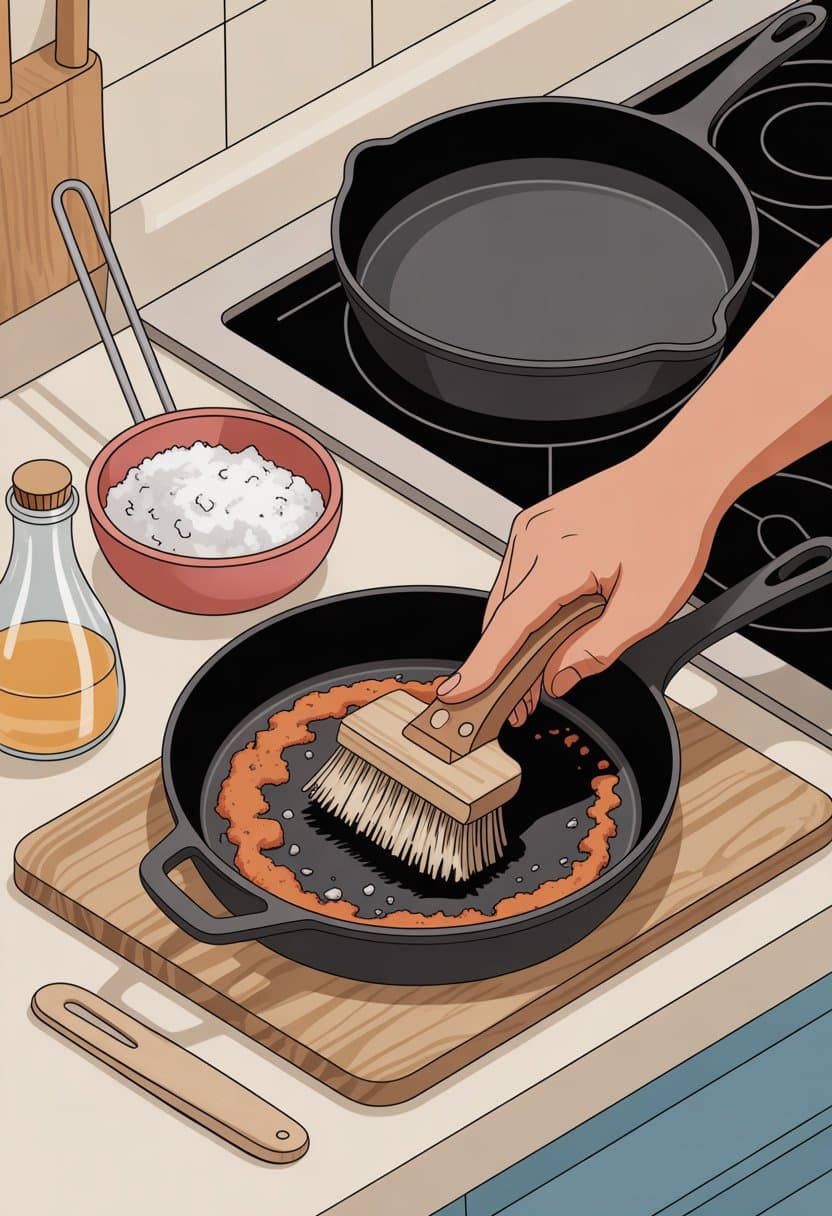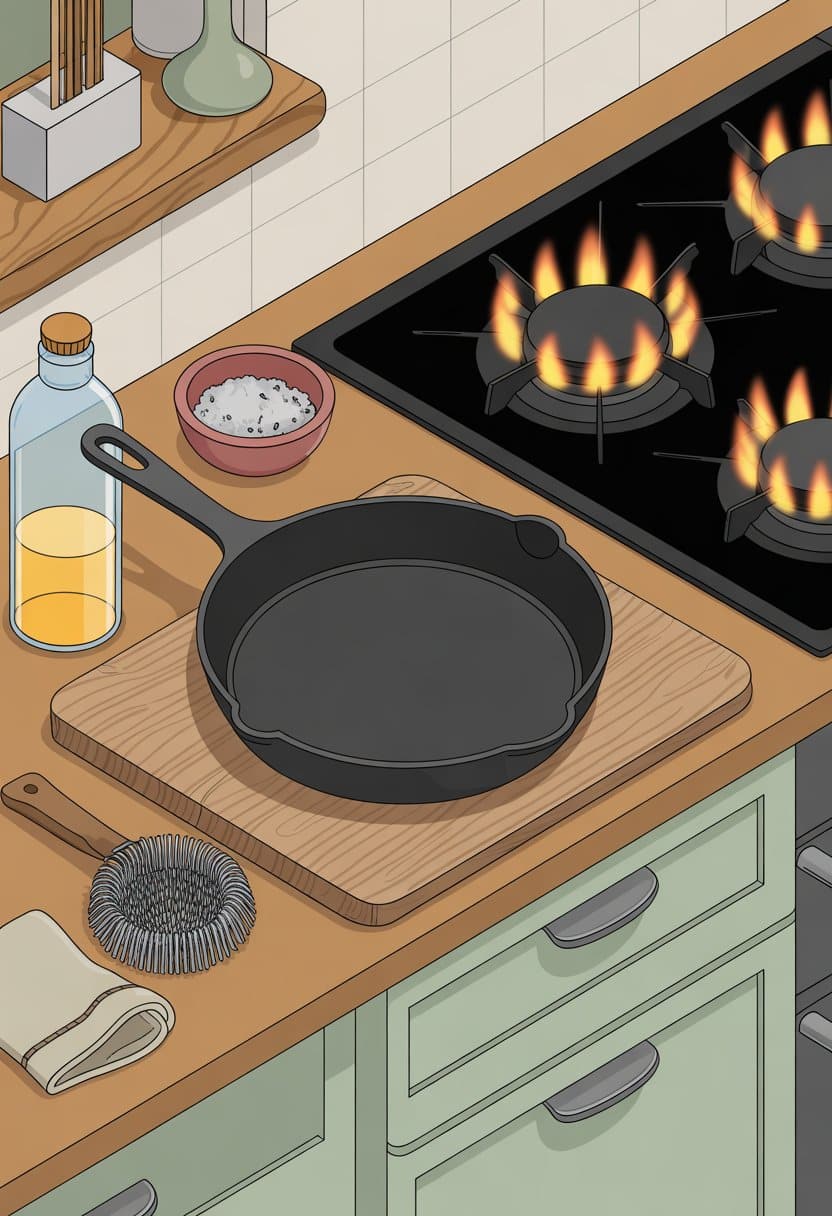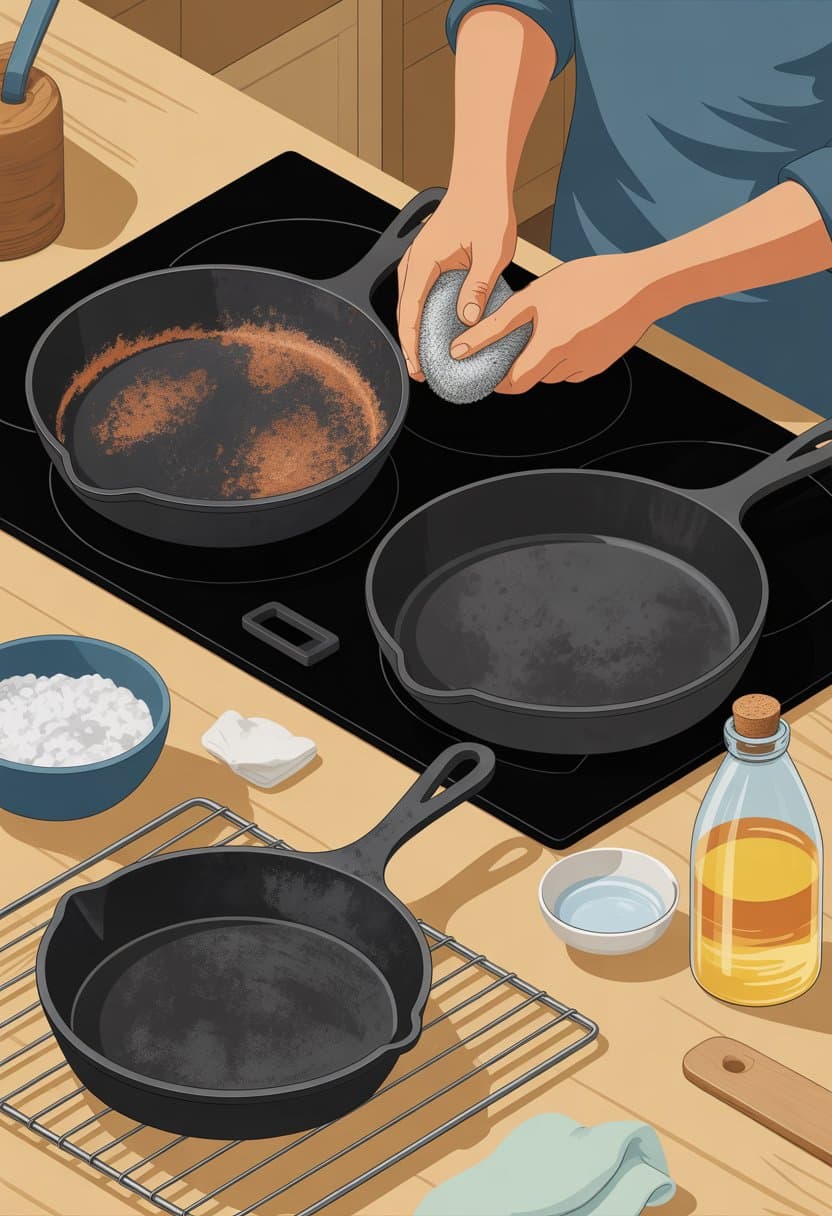Rust can make your favorite cast iron skillet look rough, but that doesn’t mean it’s a lost cause. You can remove rust from cast iron with basic tools like steel wool, salt, or vinegar and bring back that smooth, black finish.
With the right steps, your cookware can last for decades and still cook like new.

You’ll see what causes rust, what supplies actually work, and how to build back your pan’s protective seasoning. Each step helps you get more confident about caring for cast iron so it stays tough and rust-free.
Maybe you’re saving a family heirloom, or just fixing a pan you left soaking too long. Either way, this guide shows you how to clean, season, and protect your cast iron for years of use.
Understanding Rust on Cast Iron
Rust forms when iron reacts with moisture and oxygen, creating that reddish-brown layer that weakens the surface. Cast iron is especially prone to it because it’s basically pure iron and the porous surface traps water if you don’t dry or season it.
Why Cast Iron Rusts
Cast iron rusts when it sits with water, humidity, or acidic stuff for too long. The metal reacts with oxygen, making iron oxide, which breaks down the protective layer.
Even a tiny bit of moisture left after washing can start the process.
Without a seasoning layer—a thin coat of polymerized oil that bonds to the metal—your cookware loses its shield. Lodge Cast Iron says this seasoning acts as a barrier between iron and moisture.
If you let the seasoning wear off or stash the pan in a damp spot, rust will show up.
You can stop rust by keeping your skillet dry, adding a light oil coat after cleaning, and storing it somewhere with low humidity.
Common Signs of Rust
You’ll spot rust on cast iron by its color and texture. It usually shows up as reddish-brown or orange patches that feel rough or flaky.
Sometimes the surface darkens in weird, uneven ways, looking dull instead of shiny.
Light rust looks like tiny specks or streaks. If it’s deeper, you might see pitting—little holes in the metal.
If the pan feels gritty or uneven when you touch it, that’s probably corrosion.
Try rubbing the area with a dry paper towel. If you get orange dust, it’s rust. The Kitchn’s guide has more on these signs.
How to Identify Rust vs Stains
Not every weird color on cast iron is rust. Stains from food, oil, or old seasoning can look similar but act differently.
Stains are usually darker, smoother, and won’t flake or leave color when you touch them.
Rust feels coarse and powdery. It can dull the pan’s surface and will spread if you ignore it.
If you scrub a stain, it’ll usually fade but won’t show bare metal. Scrubbing rust, though, exposes a lighter gray underneath.
A quick trick: dampen the spot and wipe it with a paper towel. If you get reddish or orange residue, it’s rust. If it’s dark brown or black, it’s probably just old oil or seasoning.
Essential Tools and Supplies for Rust Removal
You can tackle rust on cast iron with a handful of household items and a few basic tools. The right stuff helps you clean well, protect the metal, and get the pan back in shape for daily cooking.
Steel Wool and Scrubbing Pads
Steel wool and scrubbing pads are your main tools for fighting rust. Grab fine- or medium-grade steel wool to scrub off surface rust without hurting the metal.
For lighter rust, a non-abrasive scrubbing pad does the trick.
If rust is stubborn, use steady pressure and scrub in small circles. You can also sprinkle in coarse salt for extra cleaning power.
The Spruce even suggests aluminum foil as a backup if you’re out of steel wool.
After scrubbing, wash the pan with warm, soapy water and dry it fast. Any leftover moisture can bring rust right back.
Keep a lint-free cloth handy for drying. This gets the surface ready for seasoning.
Vinegar and Baking Soda
White vinegar and baking soda dissolve rust using gentle chemical reactions. Mix equal parts white vinegar and water in a bucket or sink.
Soak the cast iron for 30 to 60 minutes, just until the rust starts to loosen. Don’t leave it too long—vinegar can eat into the metal.
Pull out the pan, scrub with steel wool or a stiff brush, then rinse and dry with a towel.
If you want a gentler approach, make a baking soda paste with water and spread it on rusty spots. Scrub and rinse until things feel smooth.
Mom Prepared shows these natural ingredients are safe and don’t stink up your kitchen.
Cooking Oils for Seasoning
After you get rid of the rust, you’ll need to re-season your cast iron to bring back its shield. Use a thin coat of cooking oil—canola, vegetable, or flaxseed oil all work.
Spread it evenly with a paper towel, covering every surface.
Place the pan upside down in the oven at 350°F for about an hour. This lets the oil bond to the metal and builds a nonstick layer that keeps rust away.
The Spruce recommends this method for most pans.
For best results, wipe your pan with a bit of oil after each wash. Regular seasoning keeps it tough and ready for your next meal.
Step-by-Step Guide to Removing Rust From Cast Iron
Removing rust from cast iron just takes the right tools, some cleaning agents, and a bit of care. You can use basic household stuff to lift rust, restore the surface, and get the pan ready for seasoning without wrecking it.
Manual Scrubbing for Light Rust
You can remove light rust with steel wool, a cast iron brush, or coarse salt. Scrub the rusty areas using firm, circular motions.
Focus on the visible rust until the surface feels smooth.
Wash the pan with warm, soapy water. Use a little mild dish soap to clear off any residue.
Rinse well and dry the skillet completely with a lint-free towel. Any leftover moisture can bring new rust.
Finish by applying a thin layer of cooking oil over the whole pan. Buff it in with a paper towel, then heat the pan on low for a few minutes to help the oil stick.
The Kitchn’s tutorial recommends this simple method.
Vinegar Soak Method for Heavy Rust
If rust covers most of the pan, a vinegar soak works well. Mix equal parts white vinegar and warm water in a big enough container to submerge the pan.
Let the cast iron soak for 30 to 60 minutes, checking often so the vinegar doesn’t start eating the metal.
Once you see the rust lifting, pull out the pan and scrub with steel wool or a stiff brush until it looks clean.
Rinse with water and dry right away, either with a towel or by warming the pan on low heat.
Afterward, re-season your cast iron skillet with a thin oil coat and bake it at 350°F for an hour. This brings back the protective layer.
The Spruce’s vinegar soak explains the process in detail.
Baking Soda Paste for Gentle Cleaning
For mild rust or just a touch-up, a baking soda paste does the job. Mix baking soda and water into a thick paste and slather it on rusty spots.
Let it sit for 10 to 15 minutes to loosen the rust.
Scrub with a cast iron brush or sponge, adding more paste if you need to. Rinse with warm water and dry the pan well.
Don’t leave any moisture behind.
Finally, add a light coat of oil and heat the cookware briefly to keep rust away. The Spruce’s guide mentions this gentle method for keeping your cast iron smooth without harsh chemicals.
Restoring and Seasoning Cast Iron After Rust Removal

After you remove rust, you’ve got to restore the protective surface on your cast iron. This step locks out moisture, keeps new rust away, and gives you a smooth, tough finish for cooking.
Drying and Applying Oil
Drying really matters before you add oil. Any leftover water brings rust right back.
Wipe your cast iron with a clean towel, then warm it on low heat for 5–10 minutes to chase out hidden moisture.
The surface should feel totally dry and a little warm.
Once it’s dry, apply a thin, even oil layer. Use a paper towel or lint-free cloth to coat every surface—inside, outside, even the handle.
Pick flaxseed, canola, or vegetable oil. All of them bond well to the iron when heated.
Wipe away any extra oil with a clean towel. You want it shiny but not greasy, or you’ll get sticky spots.
| Step | Action | Purpose |
|---|---|---|
| 1 | Heat pan on low for 5–10 minutes | Remove moisture |
| 2 | Apply thin oil layer | Protect surface |
| 3 | Wipe off excess oil | Prevent stickiness |
Baking to Re-Season
Baking bonds the oil to cast iron and rebuilds the non-stick coating. Preheat your oven to 400–450°F (204–232°C).
Set the pan upside down on the middle rack, with foil or a tray below to catch any drips.
Bake for about one hour. The heat makes the oil polymerize, forming a hard, black layer that shields the metal.
Leave the oven closed for even heating.
If your pan was super rusty, repeat the oiling and baking two or three times. More thin layers make a tougher finish that fights off rust and cooks better.
Guides like this one from Lodge Cast Iron suggest this process for long-term results.
Cooling and Storing Properly
After baking, turn off the oven and leave the cast iron pan inside to cool. Slow cooling helps the seasoning set evenly and keeps the pan from cracking.
Don’t put a hot pan on a cold surface. That’s just asking for trouble.
Once it’s cool, check for a smooth, dark finish. Rub a little oil over the surface before putting it away.
This extra bit of oil keeps out air and moisture. Honestly, it’s a small step but worth it.
Store cast iron cookware in a dry, ventilated area. Don’t stack it with damp pans or lids.
If you’re in a humid place, toss a paper towel between pans to soak up moisture. It’s a simple trick but it works.
Preventing Rust on Cast Iron Cookware

Keeping cast iron rust-free mostly comes down to how you clean, dry, and store it. Moisture and bad habits are the real culprits here, but a few mindful steps can make your skillet last for ages.
Proper Cleaning and Drying
Clean your cast iron skillet right after you finish cooking. Use warm water and a gentle scrub brush or sponge.
Don’t soak the pan or run it through the dishwasher. Too much water invites rust.
If food sticks, scrub with coarse salt instead of harsh soap. Lodge Cast Iron points out that even a quick rinse can leave sneaky moisture behind.
After washing, dry the skillet completely. Wipe it with a towel, then set it on a warm burner or in a low oven for a few minutes.
While it’s still warm, rub on a thin layer of oil. This keeps the seasoning in good shape.
| Step | Action | Purpose |
|---|---|---|
| 1 | Wash with warm water | Remove food residue |
| 2 | Dry thoroughly | Prevent moisture buildup |
| 3 | Oil lightly | Maintain nonstick surface and barrier |
Best Storage Practices
Stick your cast iron in a dry spot. Don’t stack wet pans or cover them with lids that trap moisture.
If you have to stack, slip a paper towel between pans. It’ll soak up any humidity.
A quick heating cycle before storage can chase off hidden dampness. The Kitchn guide suggests oiling the surface before you put it away.
That thin coating really helps keep rust at bay. It’s a small effort for peace of mind.
Keep your skillet away from humid spots like under the sink or near the dishwasher. Airflow matters, especially if your kitchen gets damp.
Avoiding Common Mistakes
Most rust pops up because of simple mistakes. Leaving your skillet to air dry, soaking it overnight, or storing food in it will all invite corrosion.
Cooking acidic stuff like tomatoes or vinegar-based sauces too often can wear out the seasoning. Sometimes you just have to pick your battles.
Don’t use too much oil when seasoning. Thick layers get sticky and weird.
Wipe off extra oil before heating. Trust me, it’s worth it.
Skip cleaning tools that scratch, like steel brushes or metal scouring pads. Gentle care and regular use keep cast iron smooth and tough.
Special Considerations for Different Cast Iron Items

Different cast iron pieces need their own approach based on size, shape, and how rusty they are. The way you clean, dry, and re-season might change depending on the item and its condition.
Cast Iron Skillets and Pans
A cast iron skillet or pan usually gets surface rust from moisture or bad storage. Scrub rusty spots with steel wool or a stiff brush.
Use warm, soapy water to get rid of loose residue. Rinse and dry it well with a lint-free cloth.
Rub a thin coat of oil all over. Bake it upside down in the oven at 350°F for an hour.
This helps bring back a smooth, nonstick surface. Don’t soak skillets in water for long.
For heavy rust, try a short vinegar soak as shown in this step-by-step guide. Always re-season after deep cleaning to keep rust from coming back.
Cast Iron Dutch Ovens and Griddles
Dutch ovens and griddles can rust inside and out because of their size and how often they see liquids. For light rust, scrub with coarse salt and a damp sponge.
If the rust is deeper, use a baking soda paste or a vinegar soak for no more than an hour. After cleaning, dry the item completely.
Set it on a warm burner for a few minutes to get rid of hidden moisture. Coat the whole thing lightly with oil and bake as you would a skillet.
Don’t soak enamel interiors in vinegar. Stick with gentle scrubbing and careful drying for those.
You’ll find more details in this rust removal guide for cookware.
Vintage and Heavily Rusted Pieces
Old cast iron, especially the heavily rusted kind, usually needs extra time and care. Start by scrubbing away loose rust with a wire brush or steel wool.
If you see thick rust, try soaking the piece in a mix of vinegar and water—half and half works. Check it every 30 minutes so you don’t accidentally damage the metal.
Still see stubborn rust after soaking? Go for another round or gently use fine sandpaper to smooth things out. Make sure the piece is totally dry.
Rub on a thin layer of oil, then bake the cast iron to help rebuild its seasoning.
Antique pieces sometimes have pitting or flaking. Handle them gently if you want to keep their structure intact.
Need more help? Check out this expert guide on restoring antique cast iron.

